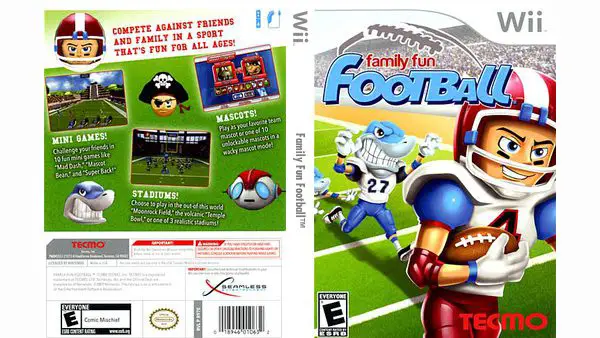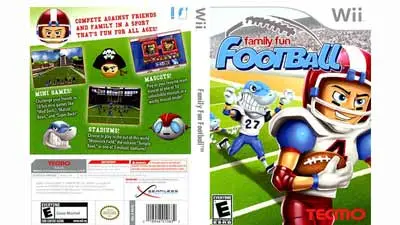
Today on Games You Probably Haven’t Played, we have Family Fun Football.
Developed by Seamless Entertainment and published by Tecmo, it was released on September 29, 2009. It is a standalone title, neither part of a series of games or released on any systems other than the Wii.
I’m going to assume that anybody reading this – at least if you are from the United States – understands the concept of football and does not need it explained to them. As such, I will instead provide a bit of a history lesson before delving into my rundown of the game itself.
Tecmo is not a significant company these days. But back during the NES era and early SNES era, Tecmo was to sports games what EA would become in the late ’90s and beyond. Their best-known sports game was an NES game called Tecmo Super Bowl. It is widely considered the best football game on the NES, if not the best sports game overall on the system.
Tecmo Super Bowl has a cult following to this day. In fact, there are internet communities that will update an online version of the game every season to include current player rosters. And all for a game that’s about 30 years old.
The reason I go into all that is because Family Fun Football is clearly an effort to jumpstart that legacy and bring it to a new generation of gamers. Family Fun Football is a mixture of some elements of Tecmo Bowl – the predecessor to Tecmo Super Bowl – some elements of Madden, and some elements not borrowed from either of those games.
So, Family Fun Football is played in the third-person – like a Madden game – on a field only fifty yards in length instead of a full field. Tecmo Bowl had a full field, but this game is clearly trying to be more of an arcade-style game whereas Tecmo Bowl and Tecmo Super Bowl were going for simulation within the restrictions of the time.
The game only has ten teams (two of them have to be unlocked), and none of them are actually NFL teams. That is an understandable thing, though, because after the 2005 sports game year saw 2K Sports dip into Madden sales after making NFL 2K5 a budget title, EA talked the NFL into giving them an exclusive license, which means Family Fun Football couldn’t have used real teams. As such, each team has its own team advantages and disadvantages so you can choose a team that is best for your playstyle. The individual players are not named.
The basics
Gameplay is quite simple. Kicking can be handled through lifting the Wii Remote, but the B button is far more precise for timing properly. The same kicking mechanic is used for kickoffs, punts, and field goals. You don’t have to aim for a field goal in this game. You just have to give the kick enough power for it to reach the upright. That wasn’t the case in Tecmo Super Bowl. The intention was clearly to make the game simple and accessible; basic kicking definitely helps do so, even if it makes things less satisfying for actual football aficionados.
On offense, for each play, you pick a play from the four available to choose from. Each play, you have an option for an inside run, an outside run, a short pass, and a long pass. The offense chooses which play they want to run by hitting a direction on the control pad and hitting the B button. They are not the same four options every time, though, which adds a slight amount of variety to the number of plays available, but having only four available at a time does make it easier for a human defender to figure out which play you’re running. Making things slightly harder, though, is the fact that the player on offense can flip the play by holding the A button as well as the B button when they pick their play.
The defense also has its choice of the same four plays. Like in the older Tecmo Bowl games, the defense picks which play it wants to defend against instead of picking its own defensive scheme. As a bonus, if the defense picks the same play as the offense, their players get a stat boost for the play, though it isn’t as crazy of an effect as in Tecmo Super Bowl where the entire defense would just plow over the offensive line and basically dogpile whoever the ball carrier was.
After a play is chosen by both sides, you go to the field. I’ll spare you a full rundown of the controls for gameplay, and will instead only say that the controls on both offense and defense are quite simple and easy to pick up on. The one major thing in this game that isn’t in a Madden game is the grapple mechanic from Tecmo Bowl where two players, one from each team, will basically get stuck together and each team will have to mash the A button to try to establish dominance over the other team’s player. The winner throws off the losing team’s player. This results in a tackle if the defender wins and a continuation of play if the player on offense wins.
On fourth down, depending on your field position, you have three play options. You can punt or attempt a field goal (depending on field position), or fake doing so for a run or a pass. There is no option to go for it on fourth down with a normal play, nor is there any option to go for a field goal at the end of a half or the end of the game if it is not fourth down. Despite the game’s more arcade-like feel, that seems like a glaring omission to me.
Power-ups
There are two other changes, though, which make it clear that this game is intended to be more arcade-like and accessible than a Madden game. First off, the field is only 50 yards long instead of 100, which makes higher-scoring games more likely. There are also three different power-ups that can be acquired by accomplishing various things in the game such as sacks, turnovers, or touchdowns, but you can only have one use of one of the three at any given time.
There is a speed boost that makes your controlled player move a lot faster for the rest of the play. This is great for running in an open field. There is a target powerup that makes your targeted player much more likely to catch a ball on offense or for a nearby defender to intercept it if used on defense. The third powerup basically knocks down every opposing player within five yards of your controlled player. This will cause a tackle if the controlled defender is close enough to the person on offense with the ball or can be used on offense to clear a running lane.
Outside of games, there are options that can be used to tailor your experience that can be set up before beginning a game. There are three difficulty levels for AI opponents, and I can confirm that it does actually matter which level you choose. If you choose rookie, you can basically run roughshod over the opposing computer team. On superstar, the highest difficulty level, things are more challenging but not overwhelmingly so. In fact, it was after playing one game on rookie to get used to the controls that I tried superstar to see what would happen, and I ended up winning 17-16. So perhaps the superstar difficulty is a smidgen on the easy side.
There is also an option to play two, five, or seven-minute quarters. I made the mistake of picking the seven-minute quarter for my first game against the rookie computer opponent and ended up putting up 160 points by the time the game was over. Even with two minute quarters against the rookie opponent, thirty to forty points is fully possible. Scores are a bit lower against the higher skill levels since moving the ball is harder, of course. I found that the game started to drag a bit with seven-minute quarters, but that was just because I was ahead by so much that the challenge was gone. In a tighter game, it could be more interesting.
As for game modes, there are basically three options. Quickplay is just a single game. Tournament is meant for when you have a lot of human players around, as it works similarly to a tournament in Super Smash Bros Melee. There’s also a season mode where you pick a team and have to play against every other team in succession. Unlike a normal season mode, in this game, you simply only advance through the season by winning each game. If you lose, you have to try again until you win.
The result is a lack of much replay value if you don’t have other people to play against. I mean, yes, there are also the ten mini-games that you can play at halftimes of the games and unlock for play at will if a human player wins them during an actual game. None of them are exciting enough that you’ll want to invest serious time into them.
Conclusion
Of the games that I have covered so far in this series, this is one of the better ones – possibly the best. It’s not great by any means, but, if you can find it for only a couple of dollars, it might be worth a few hours of playtime. It’s far from perfect, but it is fun for what it is as long as you only play it in short bursts.
